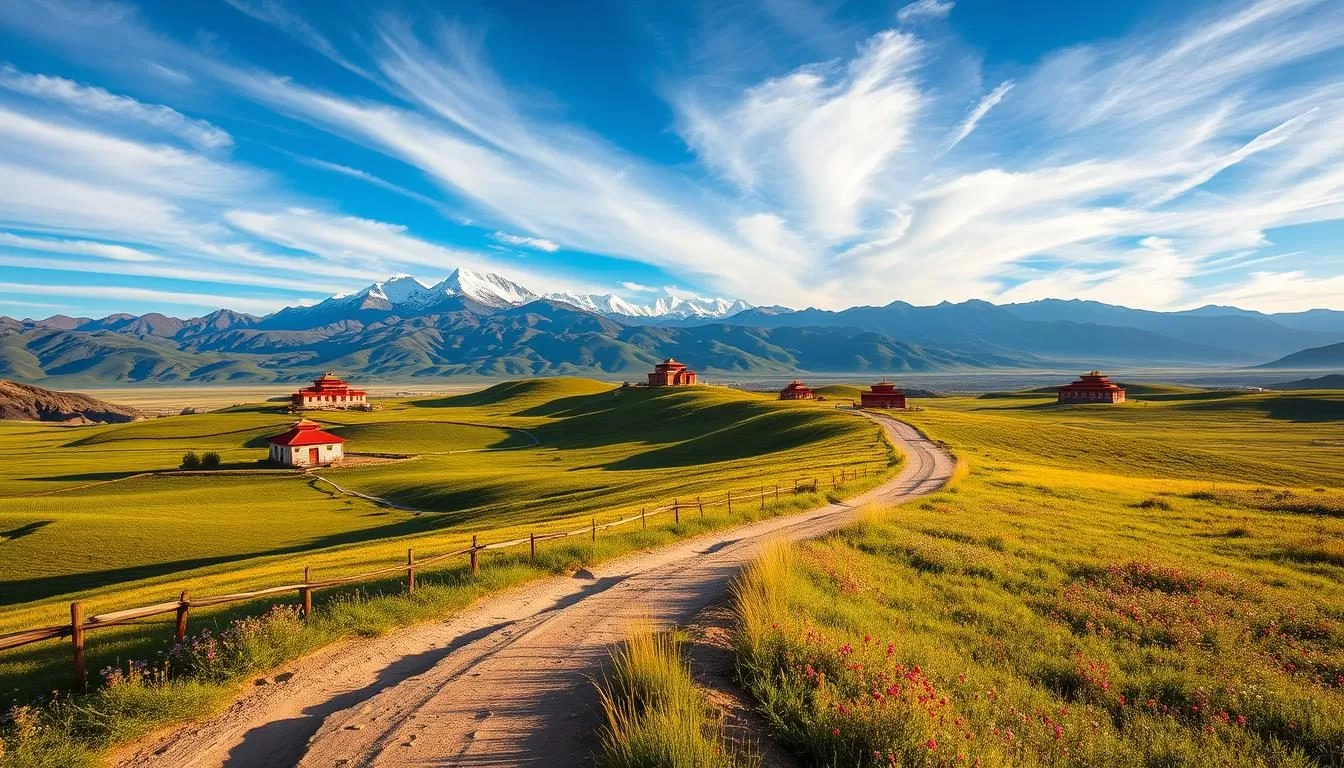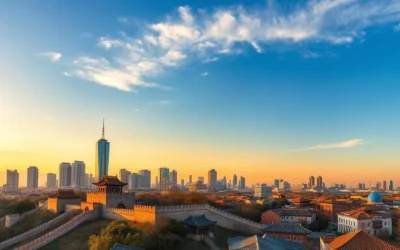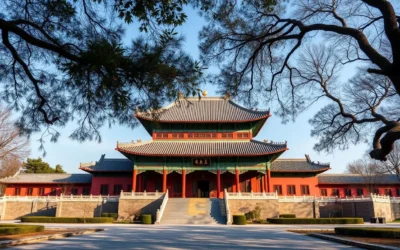✓ Accommodations✓ Flights✓ Rental Cars
Are you ready for an unforgettable adventure? This guide will take you through the heart of a land known for its spiritual heritage, breathtaking landscapes, and unique high-altitude experiences. Whether you’re planning your first trip or seeking new inspiration, this destination promises to leave you in awe.
From ancient monasteries to vibrant festivals, every corner of this place tells a story. The Potala Palace, a UNESCO World Heritage Site, stands as a testament to centuries of history and culture. Meanwhile, the vibrant streets of Lhasa, perched at 12,000 feet above sea level, offer a glimpse into a rich spiritual legacy.
This guide is packed with insider tips to help you plan your journey. Learn about must-see sites, seasonal highlights, and practical advice for a smooth travel experience. Whether you’re drawn to the serene beauty of the mountains or the warmth of local traditions, this destination is a must-visit for every explorer.
Discovering the Spiritual and Natural Wonders of Tibet
Step into a world where spirituality meets nature in its purest form. This destination is a treasure trove of deep-rooted traditions and awe-inspiring landscapes. From sacred rituals to towering peaks, every moment here feels like a journey through time and beauty.
An Overview of Tibetan Culture and Landscape
The culture here is as rich as the land itself. Ancient monasteries dot the horizon, offering a glimpse into centuries of spiritual devotion. Art and religious practices are woven into daily life, creating a unique tapestry of heritage. The Nyainqêntanglha mountain range, spanning 600 miles, adds to the region’s majestic charm.
Rivers flow through the valleys, their waters considered sacred by locals. These natural wonders are not just scenic but also hold deep spiritual significance. The connection between the land and its people is evident in every ritual and tradition.
Understanding the Unique Altitude and Climate
The high altitude of this region shapes its weather and lifestyle. Lhasa, for instance, sits at 3,650 meters, offering crisp air and clear skies. The climate can be unpredictable, with sunny days giving way to sudden rain or snow. This unique environment adds to the region’s mystique.
Travelers should prepare for the effects of high elevation. Acclimatization is key to enjoying the pristine views and vibrant festivals. The Qinghai-Tibet railway, reaching over 5,000 meters, is a testament to the region’s extreme altitude.
Whether you’re exploring sacred sites or marveling at the mountain vistas, this destination offers an experience like no other. The blend of culture and nature creates a journey that stays with you long after you leave.
Planning Your Trip: Permits, Visas, and Essential Preparations
Planning a journey to this high-altitude destination requires careful preparation. Securing the right documents and understanding the logistics are key to a smooth experience. Here’s what you need to know to get started.
Chinese Visa vs. Tibet Travel Permit
Every person entering this region must have both a Chinese visa and a tibet travel permit. The Chinese visa allows entry into the country, while the travel permit is specific to the area. Non-Chinese travelers cannot enter without these documents.
To obtain the tibet travel permit, you must work with a registered travel agency. Independent applications are not accepted. The process can take up to 20 days, so plan your time accordingly.
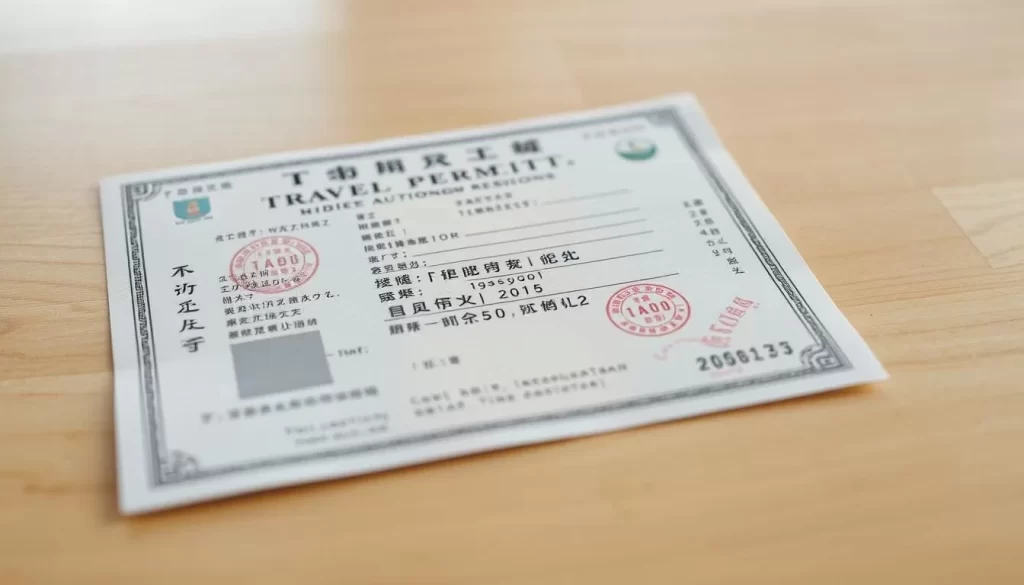
| Document | Purpose | Processing Time |
|---|---|---|
| Chinese Visa | Entry into the country | Varies by nationality |
| Tibet Travel Permit | Entry into the region | Up to 20 days |
Timing Your Visit and Weather Considerations
Choosing the right time to visit is crucial. The region is closed to foreign travelers from late February through March each year. Plan your trip outside this period to avoid complications.
Weather conditions can be unpredictable. Check current forecasts and prepare for sudden changes. High-altitude areas require extra time for acclimatization. Sleeping at intermediate elevations, like Xining, can help.
Having the right information and documents ensures a hassle-free journey. Start your preparations early to make the most of your adventure.
Exploring Lhasa: The Heart of Tibetan Heritage
Lhasa is a city where history and spirituality come alive. As the cultural and spiritual center, it offers a unique blend of ancient traditions and modern energy. From towering landmarks to bustling streets, every corner tells a story of centuries-old heritage.
Iconic Landmarks: Potala Palace and Jokhang Temple
The Potala Palace stands as a testament to the region’s rich history. Once the winter residence of the Dalai Lama, this architectural marvel rises 12,139 feet above sea level, making it one of the tallest buildings of its time. Its white and red walls house countless treasures, from sacred artifacts to intricate murals.
Nearby, the Jokhang Temple serves as the spiritual heart of the city. This sacred site attracts pilgrims from across the region, who come to pay homage and perform rituals. The temple’s golden roof and ancient statues reflect its deep religious significance.
Barkhor Street: A Spiritual Pilgrimage Experience
Barkhor Street is where the pulse of Lhasa city beats strongest. This circular path around the Jokhang Temple is a hub of activity, blending commerce and devotion. Pilgrims walk clockwise, spinning prayer wheels, while vendors sell traditional crafts and souvenirs.
The street’s vibrant atmosphere offers a glimpse into daily life and spiritual practices. It’s a place where the past and present coexist, creating an unforgettable experience for visitors.
Exploring these landmarks immerses you in the soul of Tibetan culture. Whether you’re marveling at the grandeur of the Potala Palace or soaking in the energy of Barkhor Street, Lhasa leaves a lasting impression.
Uncovering Shigatse and Gyantse: History and Heritage
Journey beyond Lhasa to uncover the hidden gems of Shigatse and Gyantse. These cities are brimming with historical and cultural treasures that offer a deeper understanding of this fascinating region. From ancient monasteries to towering forts, every place tells a story of resilience and tradition.
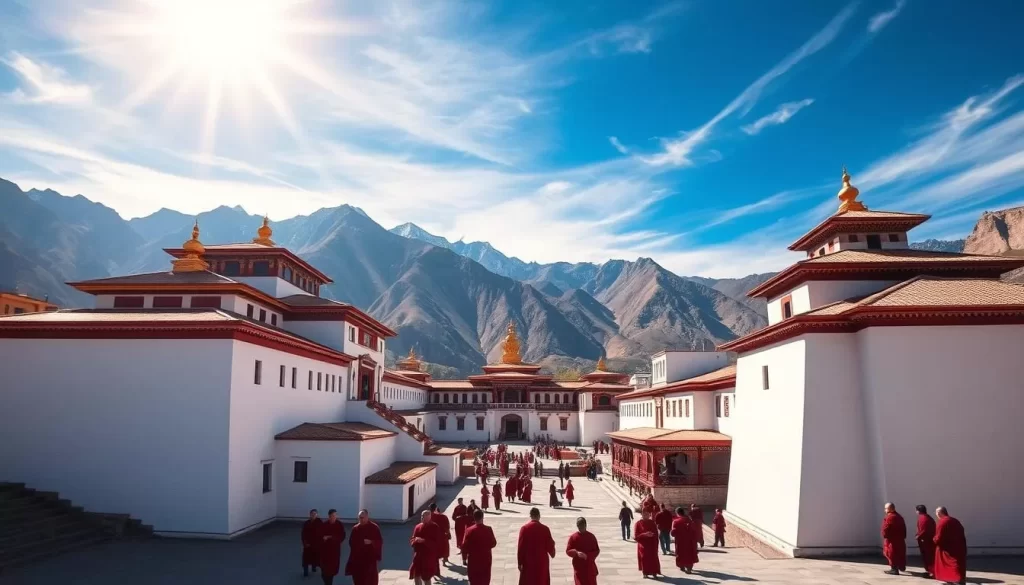
Tashilhunpo Monastery and Its Historical Significance
Founded in 1447, Tashilhunpo Monastery is a beacon of religious and historical importance. It serves as the official seat of the Panchen Lamas and houses the largest statue of the Future Buddha, standing at 26.2 meters tall. This monastery is a must-visit for anyone interested in the spiritual and architectural achievements of the region.
Smaller group tours are ideal for exploring the intricate details of the monastery. Morning visits are recommended to avoid crowds and enjoy the serene atmosphere. The day begins with the soft glow of sunlight illuminating the monastery’s golden roofs, creating a magical experience.
The Ancient Forts and Cultural Legacy of Gyantse
Gyantse is home to some of the most well-preserved forts in the region. These structures stand as a testament to the area’s rich history and strategic importance. The Gyantse Dzong, a towering fortress, offers panoramic views of the surrounding landscape and a glimpse into the past.
Visiting these forts is like stepping back in time. The intricate designs and strategic layouts reflect the ingenuity of ancient builders. For tourists, this is a chance to connect with the cultural legacy of the region in a meaningful way.
Whether you’re exploring the spiritual depths of Tashilhunpo Monastery or marveling at the architectural wonders of Gyantse’s forts, these places offer an unforgettable journey into the heart of history and heritage.
Adventures in the Mountains: From Everest Base Camp to Alpine Views
Embark on a journey where the sky meets the earth in a breathtaking display of nature’s grandeur. The mt. everest region offers unparalleled experiences for adventurers, from trekking to capturing stunning pictures of snow-capped peaks. Whether you’re planning a week-long expedition or a shorter adventure, preparation is key to making the most of your trip.
Preparing for High Altitude and Acclimatization Tips
Trekking to mt. everest Base Camp, located at 5,200 meters (17,060 feet) above sea level, requires careful planning. The high altitude can pose challenges, so acclimatization is essential. Start your journey with a gradual ascent, allowing your body to adjust. Hydration and rest are crucial to prevent altitude sickness.
Packing the right gear is equally important. Bring thermal layers, a windproof jacket, and sturdy boots to handle the snow and icy conditions. A headlamp and portable chargers ensure you’re prepared for any situation. Remember, proper preparation enhances your experience and keeps you safe.
Capturing the Sublime Himalayan Scenery
The views from the mt. everest region are nothing short of spectacular. To capture the beauty, bring a DSLR camera with extra batteries and a tripod. Early mornings and late afternoons offer the best lighting for pictures. Focus on the contrast between the towering peaks and the vast, open skies.
Every trail offers a new perspective, so take your time to explore. The best months for clear views are April, May, June, September, October, and November. Avoid July and August, as the rainy season may obscure the scenery. With the right preparation, your journey will be as memorable as the pictures you take.
| Preparation Tips | Details |
|---|---|
| Acclimatization | Gradual ascent, hydration, and rest |
| Gear | Thermal layers, windproof jacket, sturdy boots |
| Photography | DSLR camera, extra batteries, tripod |
Exploring Eastern Tibet: Kham, Amdo, and Beyond
Discover the hidden gems of Eastern Tibet, where culture and nature intertwine. This area offers a unique blend of ancient traditions, breathtaking landscapes, and warm hospitality. Unlike the more frequented central regions, Kham and Amdo provide a deeper, more authentic experience for travelers.
Cultural Richness of Tsedang and Its Monasteries
Tsedang is a treasure trove of spiritual and historical significance. The monasteries here, such as Samye and Drepung, are steeped in centuries of tradition. Samye Monastery, over 1,200 years old, is a testament to the region’s enduring heritage. These sacred sites offer a glimpse into the spiritual heart of Eastern Tibet.
Exploring these monasteries is a journey through time. The intricate murals, ancient scriptures, and serene courtyards create a peaceful atmosphere. For tourists, it’s an opportunity to connect with the region’s rich cultural legacy.
Local Cuisine and Warm Tibetan Hospitality
Eastern Tibet is also known for its authentic cuisine and welcoming atmosphere. Traditional dishes like momo (dumplings) and thukpa (noodle soup) are staples that make you feel at home. Pair these with a cup of butter tea for a truly local experience.
The region’s hot springs add another layer of relaxation to your journey. These natural wonders are perfect for unwinding after a day of exploration. The warm waters and scenic surroundings create a soothing retreat.
| Highlights | Details |
|---|---|
| Monasteries | Samye, Drepung, and other ancient sites |
| Cuisine | Momo, thukpa, and butter tea |
| Hot Springs | Natural thermal baths for relaxation |
For those planning a longer journey, consider the Chengdu to Lhasa Overland Tour. This 13-day adventure takes you through Eastern Tibet, showcasing its stunning landscapes and cultural centers. It’s an excellent way to immerse yourself in the region’s beauty and heritage.
Eastern Tibet is a haven for travelers seeking authenticity. From its ancient monasteries to its warm hospitality, every moment here feels like a journey into the heart of Tibetan culture.
Tibet Autonomous Region, China: Best Things to Do – Top Picks
This region offers a unique blend of spirituality, history, and natural beauty. Whether you’re planning a short trip or an extended tour, every moment here is filled with wonder. From ancient monasteries to towering peaks, this destination is a treasure trove of unforgettable experiences.
Insider Recommendations for an Unforgettable Journey
For a truly immersive travel experience, consider these insider tips:
- Explore the Potala Palace, a UNESCO World Heritage Site, to witness centuries of history.
- Visit Barkhor Street in Lhasa, where spirituality and commerce come alive.
- Take a tour to Everest Base Camp for breathtaking views and a sense of adventure.
Customized private tours allow you to design your itinerary, while group tours offer a structured experience. Both options provide unique ways to explore this remarkable region.
Why This Destination Should Be Your Next Adventure
Here are compelling reasons to plan your visit tibet:
- Rich cultural heritage: Discover ancient monasteries and vibrant festivals.
- Stunning landscapes: From snow-capped peaks to serene valleys, the scenery is unparalleled.
- Memorable day trips: Explore hidden gems like Shigatse and Gyantse for a deeper connection to the region’s history.
Taking time to fully experience each attraction ensures a meaningful and enriching trip. Whether you’re drawn to the spiritual or the scenic, this destination has something for everyone.
For more detailed planning, check out the Tibet Travel Guide 2025. It provides essential tips and insights to make your journey seamless and unforgettable.
Practical Tips for a Smooth Journey: Health, Safety, and Etiquette
To make your journey seamless, focus on health, safety, and cultural respect. Proper preparation ensures a memorable and enriching experience. Here’s how to stay safe and respectful throughout your adventure.
Altitude Sickness Prevention and Remedies
High altitudes can affect your health, so acclimatization is crucial. Start your ascent gradually to allow your body to adjust. Stay hydrated and avoid strenuous activity in the first few days.
Pack medications like acetazolamide to prevent symptoms. Small oxygen tanks are available for purchase in Lhasa if needed. Listen to your body and rest if you feel unwell. Proper preparation ensures you enjoy the stunning views without discomfort.
Respecting Local Customs and Religious Practices
When visiting sacred sites, dress modestly and remove your shoes if required. Always walk clockwise around religious structures, as this is a sign of respect. Avoid pointing your foot at statues or monks, as it’s considered impolite.
Interact with locals courteously. A simple smile or nod goes a long way. If invited into a person’s home, accept with gratitude and follow their lead. These gestures show appreciation for their culture.

For more detailed travel tips, check out this comprehensive guide. It offers valuable insights to enhance your journey.
| Tip | Details |
|---|---|
| Acclimatization | Gradual ascent, hydration, and rest |
| Footwear | Sturdy boots for uneven terrain |
| Head Protection | Wear a hat to shield from cold and sun |
By following these tips, you’ll ensure a safe and respectful way to explore. Whether you’re a seasoned traveler or a first-time visitor, these practices will make your trip unforgettable.
Seasonal Considerations: When to Visit for the Best Experience
Timing your visit is key to unlocking the best of this destination. The time visit you choose shapes your journey, from the weather to the festivals you’ll experience. Each season offers unique opportunities, so understanding the differences ensures a memorable trip.
Comparing Seasons: Festivals, Crowds, and Weather
Winter brings a serene atmosphere, with fewer crowds and crisp, clear skies. It’s an ideal time visit for those who enjoy peaceful exploration. However, the cold temperatures can limit outdoor activities, so pack accordingly.
Spring and autumn are the most popular seasons. The weather is mild, and the scenery is stunning, with blooming flowers or golden landscapes. These months also host vibrant festivals like the Saga Dawa Festival, which honors the life of Buddha with prayers and dances.
Summer is lively but crowded. The Shoton Festival in Lhasa features traditional Tibetan opera and marks the end of the monks’ meditation retreat. While the days are warm, sudden rain showers are common, so plan for flexibility.
Maximizing Your Experience Year-Round
To enjoy the scenery regardless of the season, focus on preparation. Layered clothing is essential, as temperatures can vary throughout the day. For winter visits, thermal wear and sturdy boots are a must.
Some places shine in specific seasons. For example, Everest Base Camp is best visited in May or September for clear skies. Meanwhile, the Tashilhunpo Monastery in Shigatse is magical during the Thangka Festival, when massive tapestries are unveiled.
For more insights on planning your trip, check out this guide on the best time to visit Tibet. It offers detailed tips to help you make the most of your adventure.
- Winter: Peaceful but cold, perfect for quiet exploration.
- Spring/Autumn: Mild weather, vibrant festivals, and stunning landscapes.
- Summer: Lively and crowded, with occasional rain showers.
Budgeting Your Tibetan Expedition
Planning a budget-friendly journey doesn’t mean compromising on quality. With the right strategies, you can explore this destination affordably while still enjoying its rich culture and stunning landscapes. Here’s how to make the most of your trip without overspending.
Affordable Accommodations and Travel Options
Choosing budget-friendly lodging is a great way to save. Many Tibetan-owned guesthouses offer comfortable stays at reasonable prices. These accommodations often provide a more authentic experience, allowing you to connect with local culture.
For travel, consider joining a group tour. These tours often reduce costs by sharing expenses like transportation and guides. They also provide a structured itinerary, making it easier to explore without stress.
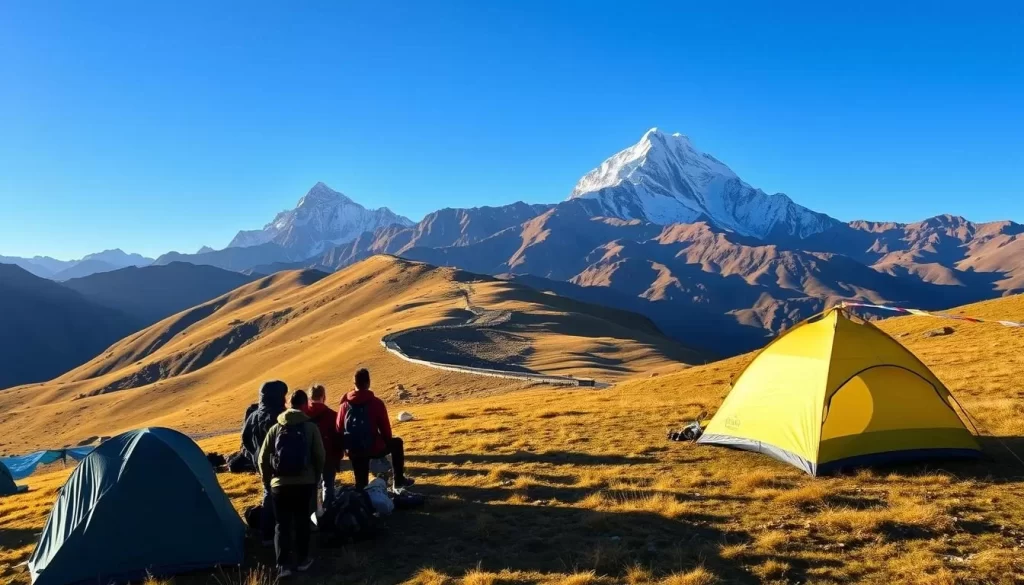
Cost-Saving Tips for Permits and Tours
Permits are essential for your journey, but they don’t have to break the bank. Book your trip well in advance to avoid premium prices. Travel agencies typically require a deposit of 10% to 50% before issuing permits, so plan your time accordingly.
Private tours can be more expensive, but joining a group can lower costs. A minimum of four people is required for private trips; otherwise, you’ll need to join a larger group. This is a smart way to balance expenses with a quality experience.
| Expense | Cost-Saving Tip |
|---|---|
| Accommodation | Stay in Tibetan-owned guesthouses |
| Travel | Join group tours to share costs |
| Permits | Book early to avoid premium prices |
For more detailed planning, check out this ultimate Tibet tour information. It offers valuable insights to help you plan a budget-friendly and unforgettable journey.
Conclusion
Your journey to this high-altitude destination promises a blend of cultural richness and natural beauty. From ancient monasteries to towering peaks, every moment here is unforgettable. Proper planning ensures a smooth experience, allowing you to fully immerse yourself in the travel adventure.
Respect for local customs and careful preparation are key. Acclimatize to the altitude, pack wisely, and embrace the unique traditions of the region. These steps will enhance your journey and help you connect deeply with the place.
Whether you’re drawn to serene landscapes or vibrant festivals, this destination offers something for every tourist. Use this guide to tailor your trip and make the most of your time. For more tips on planning your entry, check out the best entry cities to Tibet.
Prepare for an enriching experience where breathtaking views meet cultural heritage. Your adventure awaits—start planning today!
The above is subject to change.
Check back often to TRAVEL.COM for the latest travel tips and deals.
